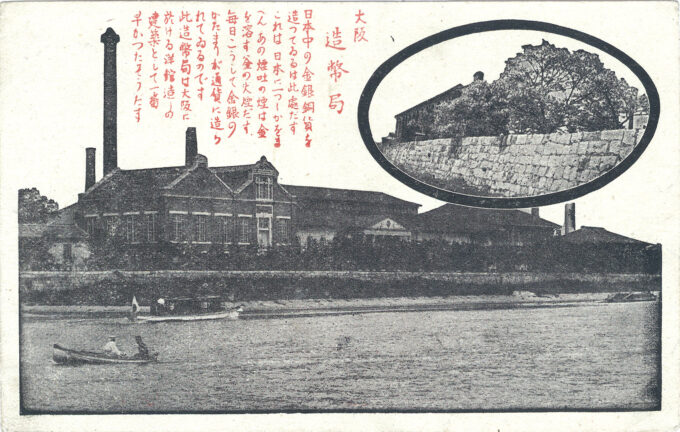
Osaka Mint, Osaka, c. 1920. The establishment of an Imperial Mint was one of the first acts of the Meiji government, and the Osaka Mint opened in April, 1871 as the means to mint coins by modern methods. The brick buildings seen in the postcard image replaced the original Mint in 1911, and the grounds were landscaped with more than 300 cherry trees.
See also:
Osaka Castle, Osaka, c. 1930.
Tsutenkaku Tower, Osaka, c. 1930.
Osaka Castle, Osaka, c. 1930.
“Our first visit [in Osaka] was paid to the mint. Curiously enough I had never been over one before, so the interest in my case was not merely local. It was quite fascinating to watch the bars of silver and copper taken red from the furnace, beaten out, and put through the machines for cutting dollars and cent pieces as a cook cuts her biscuits with a tin ‘shape.’ Another machine stamps these from below and above simultaneously, by a single pressure.
“The coins are counted out of large baskets full of every kind by an ingenious method, which is probably used in every other mint. A square piece of wood, with slightly raised rounds of the size of each special coin, is dipped into the basket and the coins put in place by a quick movement of the hands. When correctly filled up the board counted out fifty coins at a time.
“Other men were engaged in ‘passing’ the coins when first cut (before stamping) to see that they are without flaw, and finally, there is a most ingenious little instrument for weighing the coin when completely finished, to see that it is up to the standard weight. All coins go into this at the same entrance, where there is a little scale fixed, but lower down there are three divisions.
“Those that are of full weight fall into one of these, the medium weight into another, and the short weight into the third, tumbling out of those holes so marked into three different receivers.
“All the machinery used in the Osaka mint comes from Paris or England. There are five hundred and fifty men employed in the building, all of them being Japanese.”
– Kaleidoscope: Shifting Scenes from East to West, by E. Katharine Bates, 1889

